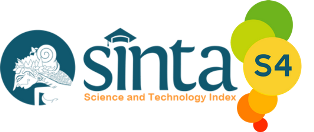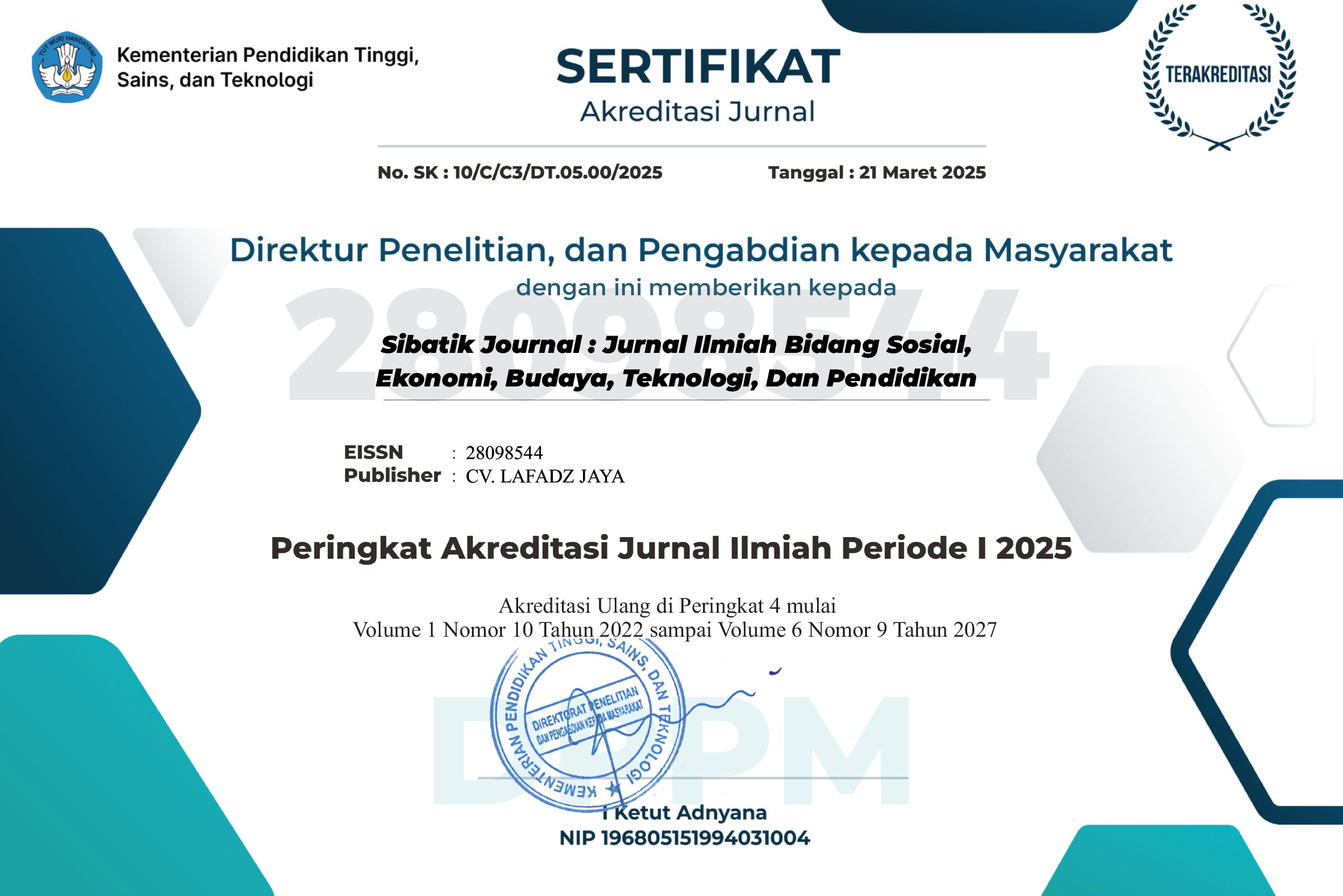PENGARUH KEPEMIMPINAN INKLUSIF TERHADAP TEKANAN KINERJA DAN SUARA TIM MELALUI INOVASI TIM SEBAGAI MEDIATOR
DOI:
10.54443/sibatik.v1i12.469Published:
2022-11-30Downloads
Abstract
Penelitian ini bertujuan untuk mengetahui dan menjelaskan Pengaruh Kepemimpinan Inklusif Terhadap Tekanan Kinerja Dan Suara Tim Melalui Inovasi Tim Sebagai Mediator. Penelitian ini merupakan penelitian kausalitas dengan menggunakan pendekatan kuantitatif. Teknik pengambilan sampel menggunakan non probability sampling yaitu purposive sampling pada karyawan PT. X Surabaya yang menggunakan analisis statistik Partial Least Square (PLS) dengan software SmartPLS 3.0. Penelitian ini menjelaskan bahwa dalam lingkungan bisnis yang kompleks dan berubah dengan cepat saat ini, inovasi tim semakin penting untuk kelangsungan hidup dan kesuksesan organisasi. Meskipun literatur yang relevan menyoroti pentingnya kepemimpinan dalam inovasi tim, penelitian sebelumnya terutama berfokus pada kepemimpinan transformasional dan telah menghasilkan hasil yang tidak konsisten. Untuk mengatasi kekosongan ini, penelitian ini mengintegrasikan teori penetapan tujuan ke dalam kerangka keluaran proses input dan mengusulkan model mediasi yang dimoderasi untuk menguji hubungan antara kepemimpinan inklusif dan inovasi tim. Hasil analisis regresi hierarkis menunjukkan bahwa suara tim memediasi hubungan antara kepemimpinan inklusif dan inovasi tim dan tekanan kinerja memoderasi hubungan langsung antara kepemimpinan inklusif dan suara tim serta hubungan tidak langsung antara kepemimpinan inklusif dan inovasi tim melalui suara tim sedemikian rupa sehingga hubungan lebih kuat ketika tekanan kinerja tinggi.
Keywords:
Kepemimpinan Inklusif Tekanan Kinerja Inovasi Tim Suara TimReferences
Academy of Management Annals, 5(1), 373–412. https://doi.org/10.1080/19416520.2011.574506 Mumford, M. D., Scott, G. M., Gaddis, B., & Strange, J. M. (2002). Leading creative people:
Alexander J. McNeil a,), Rudiger Frey b, 1. (2006). Estimation of tail-related risk measures for heteroscedastic financial time series: an extreme value approach. Journal of Empirical Finance, 3(1), 13–32. https://doi.org/https://doi.org/10.1016/S0927-5398(00)00012-8
Anat Drach-Zahavy and Anit Somech. (2006). Understanding team innovation: The role of team processes and structures. Educational Publishing Foundation, 1999(December), 1–6. https://doi.org/https://doi.org/10.1037/1089-2699.5.2.111
Australian Journal of Psychology, 34(3), 383–401. https://doi.org/10.1080/00049538208254733 Renae A. Jones, N. L. J. and A. G. (2005). The Impact of Organizational Culture and Reshaping Capabilities on Change Implementation Success: The Mediating Role of Readiness for Change.
Becker, F. G., Cleary, M., Team, R. M., Holtermann, H., The, D., Agenda, N., Science, P., Sk, S. K., Hinnebusch, R., Hinnebusch A, R., Rabinovich, I., Olmert, Y., Uld, D. Q. G. L. Q., Ri, W. K. H. U., Lq, V., Frxqwu, W. K. H., Zklfk, E., Edvhg, L. V, Wkh, R. Q., … 2015) .ح ,ﻓﺎطﻤﯽ). Making it safe: The effects of leader inclusiveness and professional status on psychological safety and improvement efforts in health care teams. Syria Studies, 7(1), 37–72. https://www.researchgate.net/publication/269107473_What_is_governance/link/548173090cf22 525dcb61443/download%0Ahttp://www.econ.upf.edu/~reynal/Civilwars_12December2010.pdf%0Ahttps://think-asia.org/handle/11540/8282%0Ahttps://www.jstor. org/stable/41857625
Blackmore, J. (2005). Educational Leadership: A feminist Critique and Reconstruction. Critical Perspectives on Educational Leadership, 63–87. https://doi.org/10.4324/9780203977927
Carmeli, A., Reiter-Palmon, R., & Ziv, E. (2010). Inclusive leadership and employee involvement in creative tasks in the workplace: The mediating role of psychological safety. Creativity Research Journal, 22(3), 250–260. https://doi.org/10.1080/10400419.2010.504654
Detert, J. R., & Treviño, L. K. (2010). Speaking up to higher-ups: How supervisors and skip-level leaders influence employee voice. Organization Science,21(1),249–270. https://doi.org/10.1287/orsc.1080.0405
E. Tory Higgins, James Shah, and R. F. (2015). Emotional Responses to Goal Attainment: Strength of Regulatory Focus as Moderator. Syria Studies, 7(1), 37–72.
https://doi.org/10.1037/0022-3514.72.3.515
Edmondson, A. C. (2003). Speaking up in the operating room: How team leaders promote learning in interdisciplinary action teams. Journal of Management Studies, 40(6), 1419–1452. https://doi.org/10.1111/1467-6486.00386
Edwards, J. R., & Lambert, L. S. (2007). Methods for integrating moderation and mediation: A general analytical framework using moderated path analysis. Psychological Methods, 12(1), 1–22. https://doi.org/10.1037/1082-989X.12.1.1
Eisenbeiss, S. A., van Knippenberg, D., & Boerner, S. (2008). Transformational Leadership and Team Innovation: Integrating Team Climate Principles. Journal of Applied Psychology, 93(6), 1438–1446. https://doi.org/10.1037/a0012716
Gardner, H. K. (2012). Performance pressure as a double-edged sword: Enhancing team motivation but undermining the use of team knowledge. Administrative Science Quarterly, 57(1), 1–46. https://doi.org/10.1177/0001839212446454
Gary Anderson. (1990). Toward A Critical Constructivist Approach to School Administration: Invisibility, Legitimation and The Study of Non-Events.
Hair et al, 2008 dalam Jogiyanto, 2011. (2021). Pengaruh Motivasi Kerja dan Iklim Kerja Terhadap Kepuasan Kerja dan Implikasinya Terhadap Kinerja Tenaga Kependidikan Institut Pertanian Bogor.
Hollander, E. P. (2009). Inclusive leadership: The essential leader-follower relationship. Routledge.
Jeff Bailey, D. du P. (2015). Understanding principals’ attitudes towards inclusive schooling. Journal of Educational Administration, 7(1), 37–72. https://doi.org/https://doi.org/10.1017/S1030011200024234
Journal of Management Studies, 42(2), 361–386. https://doi.org/https://doi.org/10.1111/j.1467-6486.2005.00500.x
LePine, J. A., & Van Dyne, L. (1998). Predicting voice behavior in work groups. Journal of Applied Psychology, 83(6), 853–868. https://doi.org/10.1037/0021-9010.83.6.853
Linda Evans. (2015). Is leadership a myth? A ‘new wave’ critical leadership-focused research agenda for recontouring the landscape of educational leadership. Educational Management Administration and Leadership, 7(1), 37–72.https://doi.org/https://doi.org/10.1177/17411432211066274
Morrison, E. W. (2011). Employee voice behavior: Integration and directions for future research.
Orchestrating expertise and relationships. Leadership Quarterly, 13(6), 705–750.
https://doi.org/10.1016/S1048-9843(02)00158-3
O’brien, G. E. (2007). Evaluation of the job characteristics theory of work attitudes and performance.
Ryan, J. (2006). Inclusive Leadership and Social Justice for Schools. Leadership and Policy in Schools, 5(1), 3–17. https://doi.org/10.1080/15700760500483995
Scott B. MacKenzie, Philip M. Podsa, N. P. P. (2019). Construct Measurement and Validation Procedures in MIS and Behavioral Research: Integrating New and Existing Tech. Management Information Systems Research Center, University of Minnesota, 35, No. 2, 9–25.
Sudibjo, N. (2021). Faktor-Faktor Yang Mempengaruhi Motivasi. Jurnal Teknologi Pendidikan, 10(1), 145–161.
Toby D. Wall, C.H.R.I.S.C.L.E.G.G. a n d P. R. . J. (2019). An evaluation of the Job Characteristics Model. MRC Social and Applied Psychology Unit, University of Sheffield, 9–25. https://doi.org/https://doi.org/10.1111/j.2044-8325.1978.tb00413.x
Walumbwa, F. O., Morrison, E. W., & Christensen, A. L. (2012). Ethical leadership and group in-role performance: The mediating roles of group conscientiousness and group voice. Leadership Quarterly, 23(5), 953–964. https://doi.org/10.1016/j.leaqua.2012.06.004
Wanberg, C. R., & Banas, J. T. (2000). Predictors and Outcomes of Openness to Changes in a Reorganizing Workplace. Journal of Applied Psychology, 85(1), 132–142. https://doi.org/10.1037/0021-9010.85.1.132
Wang, L., Wan, J., Zhang, H., & Han, L. (2020). Leader information seeking , team performance and team innovation : Examining the roles of team reflexivity and cooperative outcome interdependence. Information Processing and Management, 57(6), 102343. https://doi.org/10.1016/j.ipm.2020.102343
Ye, Q., Wang, D., & Guo, W. (2019). Inclusive Leadership and Team Innovation: The Role of Team Voice and Performance Pressure. European Management Journal, 37(4), 468–480. https://doi.org/10.1016/j.emj.2019.01.006
Zhou, J., & George, J. M. (2003). Awakening employee creativity: The role of leader emotional intelligence. Leadership Quarterly, 14(4–5), 545–568.
License
Copyright (c) 2022 Annisa Nurul Aini, Dwiarko Nugrohoseno

This work is licensed under a Creative Commons Attribution 4.0 International License.












